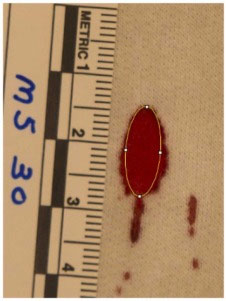Determination of angle of impact and directionality of drip stains on various fabrics
Dylan J. Drazdik, David M. Hammond, Travis J. Worst, Crystal M. Oechsle
ABSTRACT
 Bloodstain pattern analysis (BPA) on absorbent surfaces, such as fabrics, is far more complex compared to its
application on smooth, hard, non-porous surfaces. Angle of impact and directionality are commonly interpreted
from bloodstains but may be adversely affected by porous surfaces. In fact, there is a lack of evidence that
traditional approaches to BPA are even applicable when blood impacts absorbent materials such as clothing and
other fabrics. Hence, there is a critical need for research focusing on the validity and reliability of methods for
bloodstain pattern analysis on textiles. Here, human blood drops were deposited on six different fabric types
(cotton, satin polyester, rayon, blended polyester/spandex, blended nylon/spandex, and blended modal/polester/spandex) at two known impact angles: 30? and 10?. Bloodstain morphology was found to be unique for
each fabric. Calculated angles of impact for cotton and satin polyester were not statistically different from the
known angle of impact while blended polyester/spandex, blended nylon/spandex, and blended modal/polyester/
spandex significantly underestimated the known angle of impact. Even when stain morphology on fabric
resembled those on a glass control, the angle of impact significantly underestimated the known. The ability to
assign directionality based upon bloodstain morphology was dependent on the fabric type. These findings
support the need for further research and the development of guidelines for bloodstain pattern interpretation on
fabric materials.
Bloodstain pattern analysis (BPA) on absorbent surfaces, such as fabrics, is far more complex compared to its
application on smooth, hard, non-porous surfaces. Angle of impact and directionality are commonly interpreted
from bloodstains but may be adversely affected by porous surfaces. In fact, there is a lack of evidence that
traditional approaches to BPA are even applicable when blood impacts absorbent materials such as clothing and
other fabrics. Hence, there is a critical need for research focusing on the validity and reliability of methods for
bloodstain pattern analysis on textiles. Here, human blood drops were deposited on six different fabric types
(cotton, satin polyester, rayon, blended polyester/spandex, blended nylon/spandex, and blended modal/polester/spandex) at two known impact angles: 30? and 10?. Bloodstain morphology was found to be unique for
each fabric. Calculated angles of impact for cotton and satin polyester were not statistically different from the
known angle of impact while blended polyester/spandex, blended nylon/spandex, and blended modal/polyester/
spandex significantly underestimated the known angle of impact. Even when stain morphology on fabric
resembled those on a glass control, the angle of impact significantly underestimated the known. The ability to
assign directionality based upon bloodstain morphology was dependent on the fabric type. These findings
support the need for further research and the development of guidelines for bloodstain pattern interpretation on
fabric materials.
Read the report:
 This is an Open Access article distributed under the terms of the Creative Commons Attribution-NonCommercial-NoDerivatives 4.0 International License which permits unrestricted noncommercial use, distribution, and reproduction, provided the original work is properly cited and not changed in any way.
This is an Open Access article distributed under the terms of the Creative Commons Attribution-NonCommercial-NoDerivatives 4.0 International License which permits unrestricted noncommercial use, distribution, and reproduction, provided the original work is properly cited and not changed in any way.

